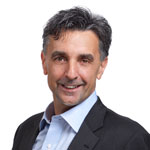My responsibilities center on the infrastructure and services that support our business. I think most employees connect with their visual environment first. The first impression is highly important because what people see day in and day out reinforces the culture the company says it has. We also want to make sure that employees see their workplace as a tool. They should have access to the technology they need to do their jobs and for training.
Michael Hirahara: Career Highlights
1989: Graduates from California Polytechnic State University–San Luis Obispo with a degree in mechanical engineering technology; joins Arco Products as a maintenance engineer immediately after graduating, taking on certain project-management and business-turnaround duties
1994: Leaves Arco Products for Silicon Graphics, where he begins working in real estate and facilities
1995-1998: Relocates to the Midwest to manage real estate and facilities for Cray Research, a recent Silicon Graphics acquisition
2003: Leaves Silicon Graphics as a vice president
2004: Joins Volex, a specialty-design cable-manufacturer, as its strategic marketing director
2005: Gets hired by Polycom as its head of global real estate and facilities, with a focus on developing a real estate strategy to help support financially sound business growth
2006: Joins Brocade Communications as its head of global real estate and facilities, leading the development and execution of a global real estate strategy
For any corporation’s real estate strategy, the first and foremost thing to do is understand the business strategy and then align the real estate portfolio with that strategy. Focusing on that alignment can really create a lot of value.
My professional career after graduating started out in oil and gas. I have an engineering degree and went into oil and gas really trying to use my engineering skills, but I also had an idea about getting involved in project management.
After school, I joined Arco Products. I started out as a maintenance engineer but then took on some project-management roles. That was probably the job that gave me the most interest in management and introduced this idea that there’s a great intersection between tech management and people management.
I then went to Silicon Graphics. The big idea going there was that I wanted to get back into technology. I had done a lot of computer programming in high school and college and liked the technology side of things. At Arco, I was able to add value to a lot of projects by finding ways to integrate technology or process management into what I was doing.
I left Silicon Graphics as a VP but still felt like I didn’t have as much business experience as could be useful in the long run. I wanted to get some marketing experience and landed a job working as the strategic marketing director for a specialty-design cable-manufacturing company called Volex. It was a little twist but proved to be a really valuable experience. When I came back into corporate real estate, my interaction with sales and marketing—and even customers—was much different.
At Brocade, we’re focused largely on utilization. It’s important to understand how a space is being used. For instance, if we have a café and one of the purposes is to encourage employee engagement, then we want to see what the patterns are in terms of how many employees get together when they’re there. Utilization is definitely a high-water mark in terms of something that we’re investing time and energy into because we see a huge return.
I pay less attention to the industry and more attention to a value proposition: how can I use my skills and abilities to add value? If I need to learn something in a particular industry or function, I just learn it. I don’t think of myself as a real estate executive or a facilities guy. What I’m focused on continues to be the business. ABQ


